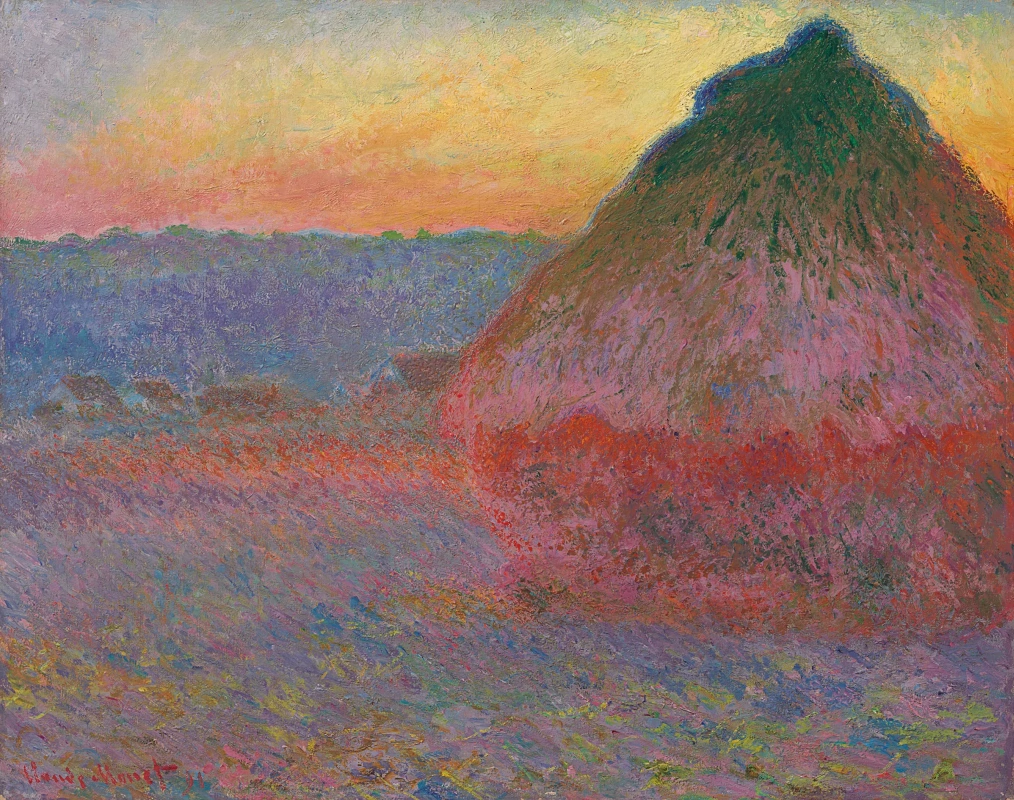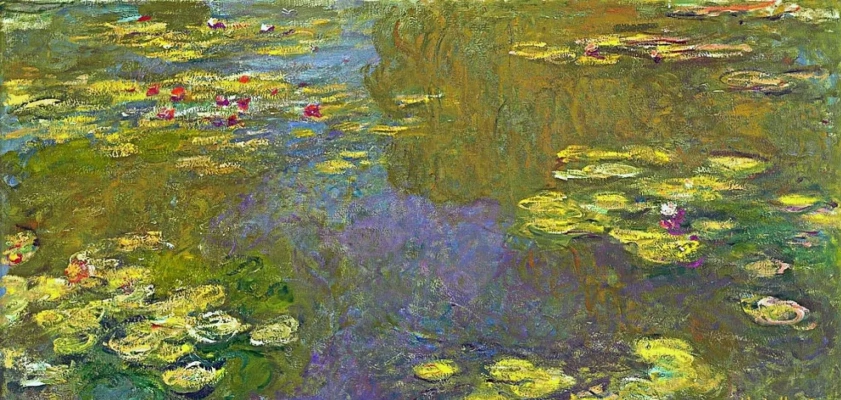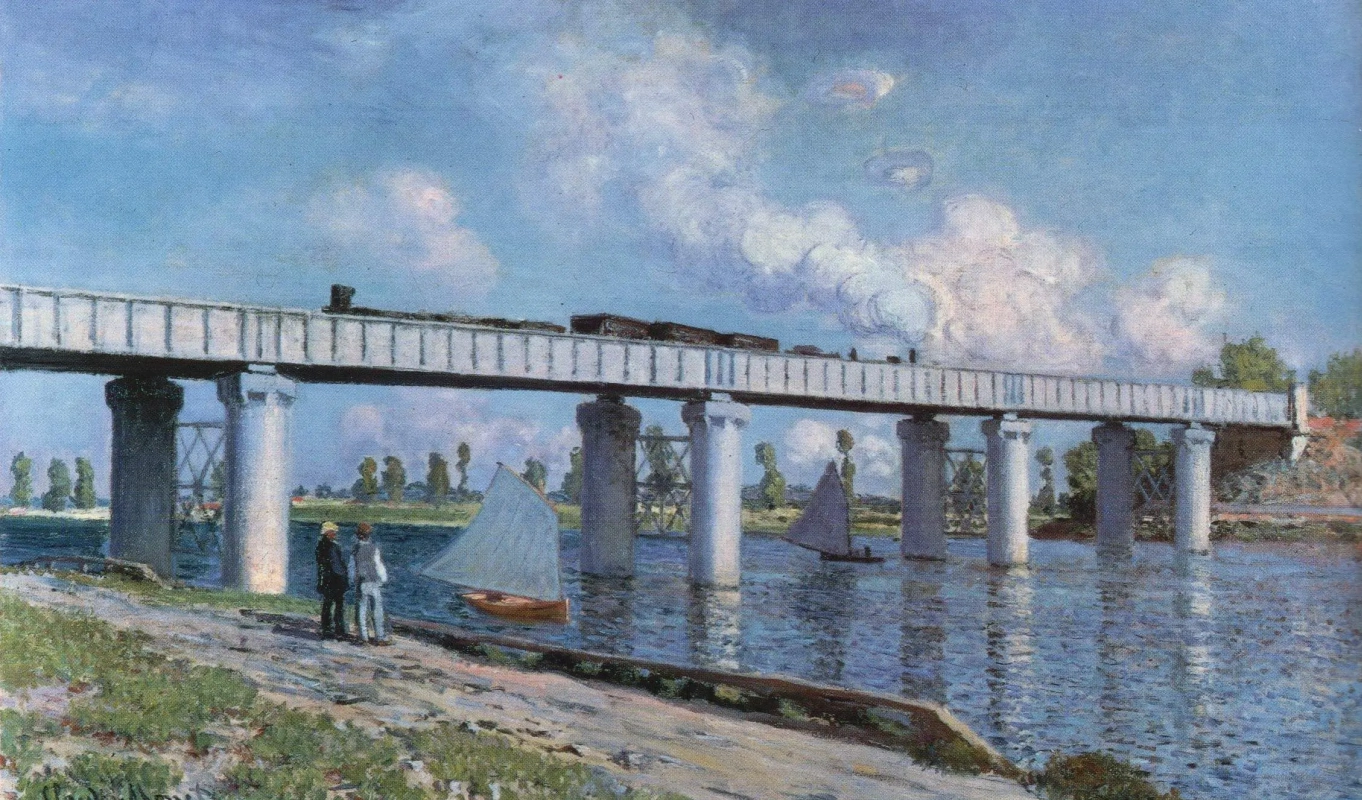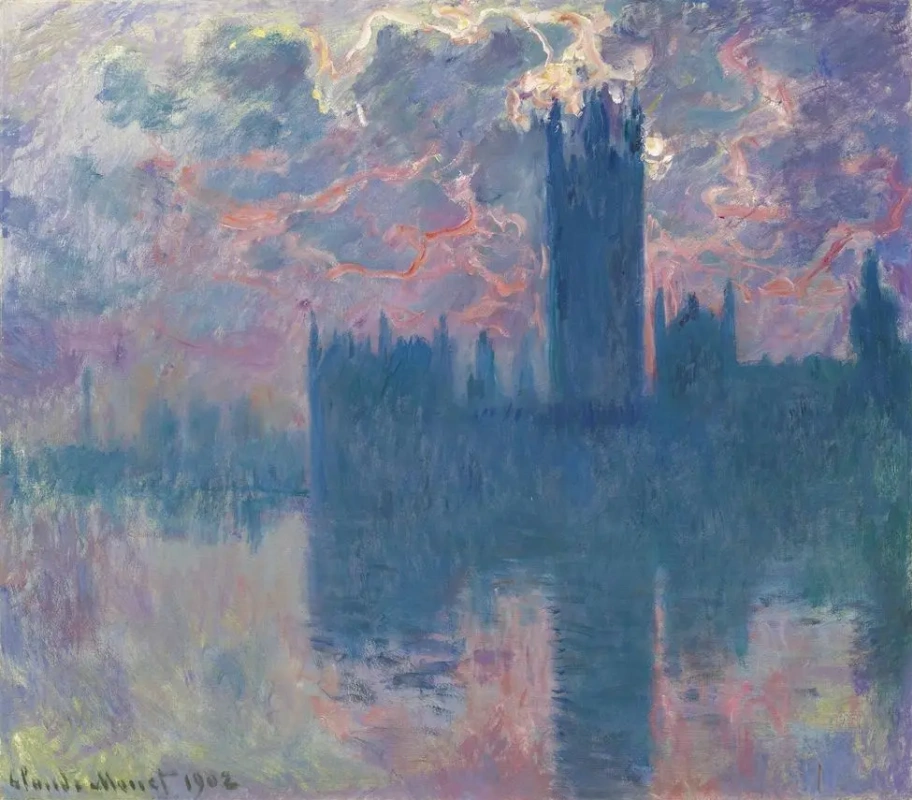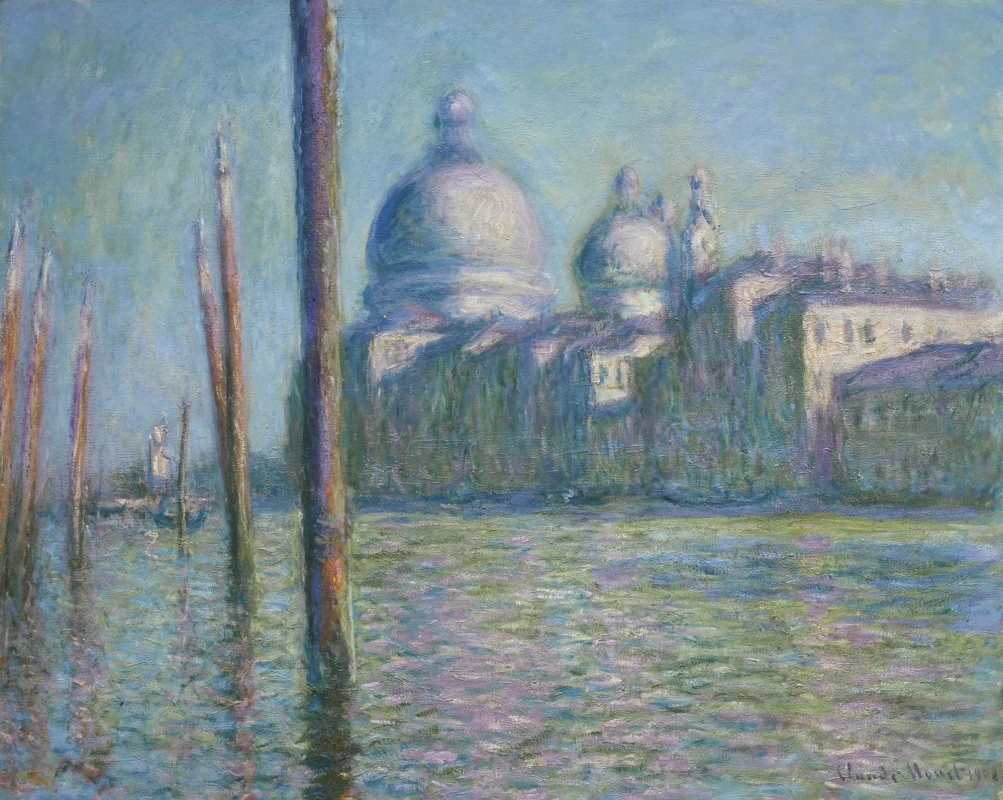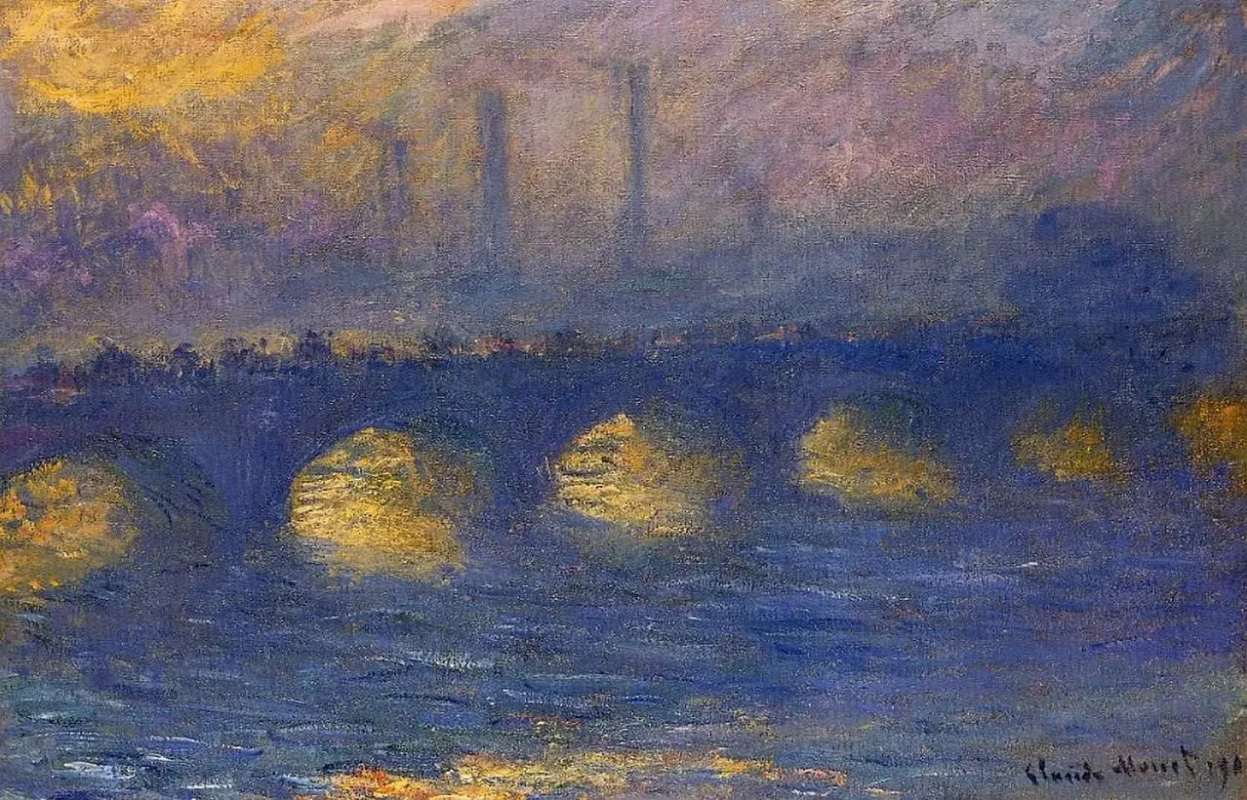When any artwork by Claude Monet is consigned to Christie’s or Sotheby’s auction houses, it is immediately announced as a top lot of an upcoming sale and its price is often higher than the appraised value. Monet’s work at an auction makes it an exciting event with agitation, passion and impressive prices.
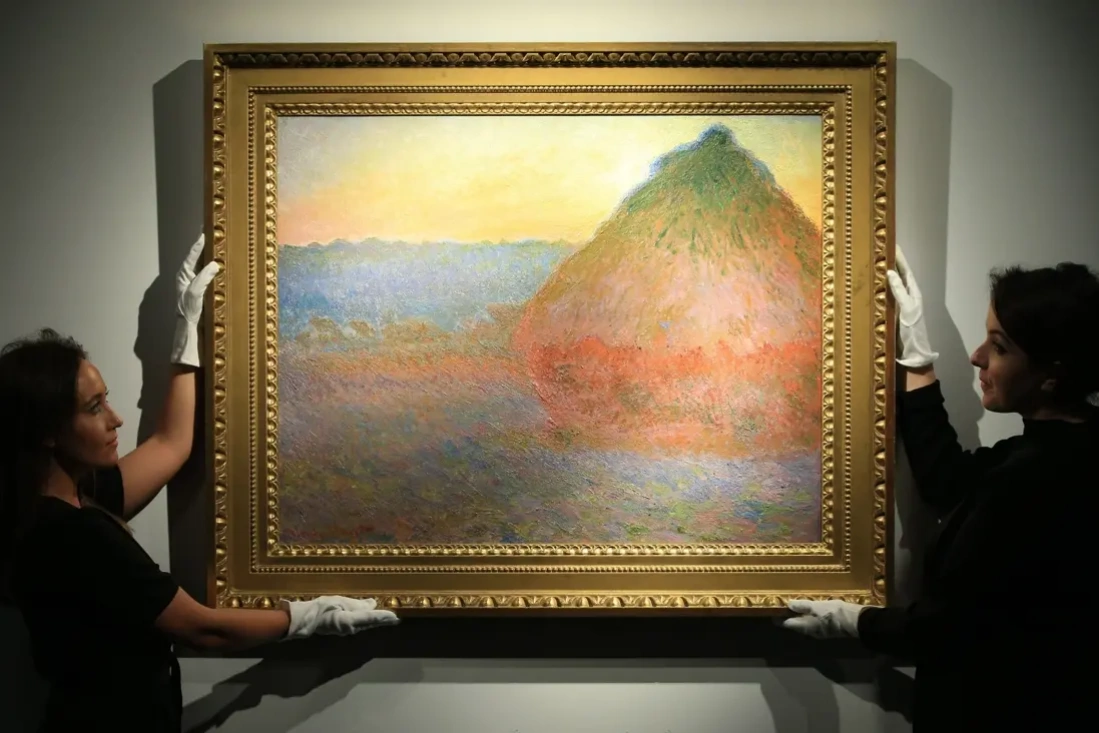
The most expensive, rather priceless masterpieces by the famous Impressionist artist are included in the collections of various museums (thanks to art dealers and philanthropists who donated their collections to the museums all over the world during the previous century). We can not put a dollar (or any other currency) tag on, for instance, the Impression. Sunrise painting by Claude Monet, or the artist’s eight Water Lilies murals at the Musée de l’Orangerie (1, 2, 3, 4). At the same time, Monet produced enough paintings of water lilies to decorate the walls of someone’s parlor with some of them.
Haystack
1891, 72.7×92.1 cm
1. Grainstack (Haystack), 1891.
Bidding: the Christie’s, 2016.Auction price: $81 447 500
Provenance: Early in 1891, Monet invited Paul Durand-Ruel to Giverny to show him a new series of works — the haystacks depicted at different seasons, at different weather conditions and at the changing light during a day. They decided to make an exhibition, which actually had a great success. Most of the paintings were bought right on the spot, at the Galerie Durand-Ruel. Monet obtained several thousands francs per picture.
A legendary American gallery Knoedler & Co was the first owner of the mentioned painting. The oldest and the most famous one, it emerged in New York long before the first American museums and big collections appeared. Founded in the USA in 1848 on a provincial art market, Knoedler & Co was a branch of a French gallery Goupil & Cie at first. Later on, Michael Knoedler, a head of the American branch, bought the affiliate and became its owner.
When an agent from the American gallery came to see Claude Monet’s haystacks' series, the artist proposed him to choose one from the five, following his demonstration with quite a rare confession, "I believe that I have succeeded well and it is not often that I say that about what I do." The painting had changed several owners in the USA, Switzerland, and France before it set a new record for Monet at the auction in 2016.
Knoedler & Co turned up at centre of a serious scandal: several collectors who bought paintings by Mark Rothko and Jackson Pollock for millions dollars in the gallery, discovered that they own master art forgeries. The oldest and most significant gallery in the USA closed down in 2011.
About the artwork: A farmer field with haystacks was just next to Claude Monet’s garden in Giverny. In fact, the constructions depicted are not haystacks but granaries, or grainstacks, covered with conical roofs. These thatched roofs protected the grain from moisture and rodents until the very spring. The title’s exact translation from the French "Muele" is "Grainstacks," but the series has come to be known as the Haystacks.
In 1890, Monet was 50 years old. Every day during six months (from August to January), he was going out to the field west of his garden to perform one of the most important revolutions in pictorial art. The Grainstacks was the first Monet’s series of paintings composed of a huge number of canvases. It has begun a special figurative form which the artist would later continue to work on in London and Rouen. "At the start, I was just like everyone else: I thought two canvases would be enough, one for cloudy weather and one for sunshine. But no sooner had I begun to paint than the lighting changed, two were no longer enough if I was to render a truthful impression of a specific aspect of nature and not end up with a picture from a number of different impressions," Monet later said. By the end of January, he completed 25 pictures.
Gustave Geffroy, a famous French writer, a friend and biographer of Monet, saw in this series a grandiose effect stretching far beyond the farmer field in Giverny. For him, the haystacks represented "the poetry of the universe in the small space of a field., a synthetic summary of the meteors and the elements."
To comprehend the poetry of the universe today, you should go to the Chicago and Boston in the USA — the Americans bought practically all paintings from The Grainstacks Series by Monet.
A pond with water lilies
1919, 100.4×201 cm
2. Pond with Water Lilies, 1919
Bidding: the Christie’s, 2008.Auction price: $80,451,178
Provenance: Brothers Josse and Gaston Bernheim, the owners of the Bernheim — Jeune Gallery in Paris acquired the artwork directly from the hands of the artist. On the way to Bernheim’s weekend estate at Villers-sur-Mer they stopped for lunch at Monet’s home in Giverny to admire his paintings or choose some pieces for their collection. On their way back from the seaside, they brought regularly to Claude Monet fresh shrimps he liked so much. Josse’s son Henri later recollected that from time to time his father packed a painting in the box on the top of his limo to show Monet a masterpiece from their own collection and enjoy his reaction.
The painting changed its owners few times over years; it was at one time owned by Marie-Louise Durand-Ruel and then by celebrated collector Norton Simon, whose private collection was combined with the Pasadena Art Museum (California). In 2008 an anonymous buyer, who bid by phone, paid for the painting the staggering price of $80,000,000.
About the artwork: It is not a mere coincidence that for eight years this canvas has led the list of the most expensive artworks by Monet sold at the auctions. The Pond with Water Lilies is one of the large paintings (1×2 meters), which Monet produced as sketches (at the same time accomplished and perfectly done) for his multipart installation project known as the Grande Decoration. One of the artworks from the series is at the Metropolitan Museum of Art in New York, the other one was sold at the auction in 1992 for $ 12 million, and the third painting survived in two pieces: one of the ignorant owners cut it in two pieces to make the painting smaller. This is the fourth.
The word Decoration was applied first to this very painting and three more of the same series. Passion, despair and proud of the artist, who dreamed about some great gift to his country after the end of World War I, had been revealed in these first sketches and then became a powerful trigger for production of the stunning murals which found their permanent home at the Musée de l’Orangerie.

3. The Water Lilies, 1906
Bidding: the Sotheby’s, 2014.Auction price: $54,071,001
Provenance: Paul Durand-Ruel was a talented art dealer and important advocate of the impressionists at the time when nobody bought the impressionist artworks. For some dozens of years he had had the monopoly on purchasing Claude Monet’s paintings, paying him not only the price for his artworks but also supplementary annuity for the all possible rights for the artist’s pieces of art and preventing cheap selling to earning living. The Durand-Ruel's monopoly finished after Monet had became famous. When in 1909 Durand-Ruel decided to held at his gallery an exhibition of the artworks by Monet entitled the Water Lilies, the artist avoided negotiations and escaped to Venice; in a while he claimed that if Paul wanted to held the exhibition he would have to buy all the pieces he needed. Durand-Ruel did not have enough money to purchase the paintings and he offered brothers Bernheim — Jeune to pay for the other half of the future showcase. They agreed and initially the artwork was owned by the both galleries: Durand-Ruel 's and brothers Bernheim — Jeune’s; later Paul acquired it for his own gallery and in a while he kept it in his own collection. The name of a new owner of the piece of art as well as two other previous buyers' were unknown.
About the artwork: Currently the most expensive 10 artworks by Claude Monet include five pieces depicting water lilies. All of them were painted when Monet was well over 60 or even 70. A few impressionist artists were able to change their lives so dramatically and contribute a lot of revolutionary innovations into the world art like Monet had done; most of them lived to a ripe old age and won belated recognition. Monet is unique.
The thingness progressively vanished from the endless sketches of the pond: no foregrounds, no middle grounds, no further grounds, no sources of light and perspective, the lilies like beacon lights attract the attention of a viewer. The real motive, subject and theme is implied in a variable and alluring depth of the water. Renee Gimpel, an art dealer, recalled the time he saw the painting for the first time, he observed the eternal sky and water without front and backgrounds. He felt like witnessing the process of the world begetting.

4. The Water Lilies, 1905
Bidding: the Sotheby’s, 2015.Auction price: $54, 010, 000
Provenance: The history of this artwork is very much alike the history of the artworks Monet produced in his late years: the buyers and co-owners of all of them were the Durand-Ruel and the Bernheim — Jeune Galleries. Then they sold the canvas to the Kunsthaus Zürich, then it had been owned by the Swiss collectors Emil and Alma Staub-Terlinden for 20 years before it was acquired by the most affluent and the notorious Wildenstein gallery. The Wildenstins were art dealers and some members of the family besides business were involved in a serious research study of the art. Daniel Wildenstein, a grandson of the founder of the art dealers dynasty was recognized all over the world as a scientist who issued the comprehensive five-volume catalogue raisonné of the work of Claude Monet including correspondence and documentary evidences covering his life. The New York branch of the Gallery in due course switched to sales of artworks and the Branch in Paris was renamed the Wildenstein Institute currently housing more that 100 thousand photos of artworks and a large archive. It is rumoured that in XX century after the death of some artist the representative of the Gallery appeared in his dwelling much earlier than a doctor or a notary officer.
In 1955 the Gallery sold the Water Lilies painting to a private collector and had never been showcased since. A new anonymous owner paid for it $ 50 million. Currently he lives in America and his name is still unknown.
About the artwork: Daniel Wildenstein, who had surveyed so many Monet’s artworks that hardly had whoever in the world done or would have done, claimed that the most significant turning point in Monet’s oeuvre accompanied with a stunning transformation happened within the period of 1905 — 1907. The perspective and skyline disappeared from his landscape paintings in 1905. Ia was a view of a man who bent low over the water scrutinizing the movement of this heavy mass. The artworks of 1905 are covered with the dense and saturated paint layer; the water depicted in them rarely reflect a bright sky, it do not shine and is opalesced. This water is an abyss, it is bottomless.

5. The Water Lilies, 1905
Bidding: the Christie’s, 2012.Auction price: $43 762 500
Provenance: The artwork like dozens of the other paintings of water lilies were bought in equal proportions by the Durand-Ruel and the Bernheim — Jeune Galleries for the exhibition dedicated to Claude Monet’s oeuvre. In a year the painting appeared to be acquired by a private collector in America and then it was purchased by some other buyers and lived a rather dull and traditional life of a masterpiece till the last bidding in 2012 at the Christie’s auction.
That year the American billionaires had to get rid of gems of their collections. The American Internal Revenue Code tightened and rich people had to sell the masterpieces they handled for they could not afford their maintenance. Two artworks by Mark Rothko and a version of the Scream by Edvard Munch were sold at the same auction as the Water Lilies by Monet. Though, the owner of the Water Lilies was not going to save money on selling the painting, she was involved in philanthropic activities. Since 1979 the owners of the Water Lilies have been Ethel Strong Allen and her husband Herbert Allen. In 2002 Ethel, a widow that time, died and left three paintings by the Impressionist painters Claude Monet, Camille Pissarro, and Alfred Sisley to the Hackley School to be auctioned, a private school in New York where three generations of her family studied. The headmaster, after he had regained his consciousness, claimed that that donation reached the stratospheric level among all the previous donations to any educational institutions in New York. The money from selling of the artworks were invested into the educational programs.
About the artwork: The Exhibition at the Durand-Ruel Gallery in 1909 was unique, paintings of the same subject had never been collected at the same showcase before. Only water with flowers on its surface depicted in 48 artworks from the Water Lilies series were displayed at the Exhibition including the painting produced in 1905 we are talking about. Monet had never been so well received before. The critics were obsessed with excitement comparing Monet’s pieces with the last quartets by Beethoven or with the frescoes by Michelangelo in the Sistine Chapel. The exhibition offered a stunning opportunity for its visitors and collectors; the artist produced more than a hundred art pieces depicting the pond in Giverny, though he did not intend neither to sell or to exhibit his artworks. All of them were held at the museums after his death.
The railway bridge at Argenteuil
1873, 60×98.4 cm
6. The Railway Bridge At Argenteuil, 1873
Bidding: the Christie’s, 2008Auction price: $41, 480, 000
Provenance: It is difficult to imagine the most successful beginning of the provenance; this picture was presented at the Second Impressionist Exhibition in 1876. Art critic Albert Wolf wrote about that very exhibition, where he personally met that intolerable impressionists. All of them were charming young men strongly confirmed in their rightness and imagining they had found their own path in art. Communication with them was as sad as he had felt when he had seen a poor mad man in the Bicêtre Hospital. He was holding a shovel in his left hand and was running a stick over the shovel like over the violin assuring the people around him that he was performing the Carnival of Venice, which according to him had brought him a great success among the experts. That virtuoso would have stood at the entrance of the exhibition in order the buffoonery in Le Peletier street would have gained its accomplishment, according to Wolf.
The first owner of the artwork was the famous opera singer Jean-Baptiste Faure one of a few admirers of a new painting. He bought the artwork at the notorious failed auction, which took plce at the Druo Hotel, the impressionists decided to sell several pieces each to earn something for living. Buyers were not ready to pay and bought a few canvases because of their frames. However, Faure and Gustave Caillebotte saved the situation and the money they paid for the artworks allowed to compensate the costs for canvases and paints.
The artwork has an impressive list of sells and acquisitions. A new owner, who paid for the painting the highest price at the moment making $ 41,000,000, was anonymous.
About the artwork: This is the earliest piece of art by Monet among his most expensive works. The artworks of the impressionist painters of that period are housed mainly at museums and of particular historical importance. They saturate the galleries of the famous international exhibitions with a rampant and vital energy of tremendous revolutionary changes in the history of art. Such kind of a landscape, for instance, in 1873 could be a challenge, arrogant and unanimously blamed for its bad taste. The most important was that it abused the concept of landscape, which had to depict a pristine nature and allowed viewers in their mind to escape an aggressive city. All those plants with their smoking pipes, monstrous bridges and noisy locomotives vandalizing real beauty of the nature stirred resentment of salon critics and as they believed they did not deserve neither brush nor even a glance of a real artist. At the same time, Monet impressed by the innovative courage and power and stiffness of the bridge made it the most celebrated bridge in the history of the French painting.
Parliament house at sunset
1901, 81.3×93 cm
7. The Houses of Parliament. Sunset, 1900-1901
Bidding: the Christie’s, 2015Auction price: $40,485,000
Provenance: Paul Durand-Ruel was longing for Monet’s returning from London, who promised paintings of the Houses of Parliament and two bridges across the Thames. He waited for him in 1900. Though the artist was unsatisfied with his sketches and intended to visit the capital of Great Britain in a year. He was unsatisfied with his work again. For some other years he had been working at his sketches in his studio. Durand-Ruel got the promised London series only in 1904, though, his waiting was absolutely compensated: in a week the artwork the Houses of Parliament. Sunset was sold. It came to private collections in Le Havre, Paris, New York and Japan. The last but one owner of the artwork was Philip Green, a British millionaire, magnate and the owner of several top brands in clothes fashion industry, bought the artwork for $ 14,000,000 in 2001 and in 14 years he sold it for $ 40,000,000.
About the artwork: "'I can’t begin to describe a day as wonderful as this. One marvel after another, each lasting less than five minutes, it was enough to drive one mad. No country could be more extraordinary for a painter", — complained Monet in his letter from London. In the morning he painted the Waterloo and Charing Cross bridges looking through his hotel window, then afternoon he went to the St Thomas' Hospital, where he was kindly offered a terrace for his everyday paintings on the open air. Monet was working with 65 paintings simultaneously, -"much more than I could finish" - it was impossible for him to do the other way, the weather and sunny moments were changing so fast. The priceless and challenging effect of this artwork was its bright red irradiance broken with clouds and painted with one stroke of his brush.
Nowadays only five artworks of this series are in private collections the other 14 are housed in museum collections: at the Metropolitan Museum of Art in New York (1), the Musée d’Orsay in Paris (1,2), The Pushkin State Museum of Fine Arts in Moscow (1) and others.

8. The Water Lilies, 1904
Bidding: the Sotheby’s, 2007Auction price: $36,724,350
Provenance: Gustave Geffroy was one of a few courageous critics who recognized Claude Monet, Pierre-Auguste Renoir and Paul Cézanne as geniuses. He dared to write passionate reviews highly estimating their artworks at the time when the major part of public and art critics called them the garbage and mocked at them. Once Monet sent his acknowledgement to the paper La Justice for their enthusiastic review and many years later he chanced to meet Gustave Geffroy on Belle Isle where they both came in searching inspiration in 1886. Geffrroy and Money had become friends since. Gustave was the first biographer writing the life history of the painter told by the artist himself and from his long and excited letters.
Geffroy had been saving the artwork for three enigmatic years. The auction provenance read that the piece of art was lent him for a while. Whatever it meant Gefrroy had been delighting the painting he sincerely admired. Then the artwork was owned by Monet son Michael and later it was saved in the private collection and the offspring of the owner sold it in 2007.
About the artwork: When in the 1900s Monet developed his favorite motive he had never thought about the Grand Decoration and the oval hall of the exhibition which walls would be decorated with the water surface without frames and boundaries. The artist flabbily thought about a man who wanted to surround himself in his own house. According to the artist he would like to use the theme of water lilies for decoration of his parlor: covering the walls and the entire interior it would make an illusion of the endless entire, the water surface without the skyline and banks. The nerves disordered with hard work would find there peace and calm like slack water. If somebody lived in such a room for a while it would become an asylum for peaceful meditation in the center of an aquarium with blossoming plants.
No doubt, a person, who has paid for this piece of art $ 35,000,000, each evening calms his nerves disordered with hard work, looking at the slack water.
The Grand canal
1908, 73×92 cm
9. The Grand Canal, 1908
Bidding: the Sotheby’s, 2015.Auction price: $35,567,406
Provenance: Monet suffered so much when learnt about selling of his artworks to Americans, barbarians, who were strange, noisy and boasted with rolls of bills. However, Durand-Ruel handled Monet’s patriotic feelings without gloves. Sometimes all the artworks after having been exhibited at his gallery was moved to the houses of rich Americans, who were fond of Impressionism. The first owner of the artwork from the esteemed series the artist painted in Venice was Hunt Henderson, a New Orleans-based sugar magnate and well-known collector of the famous artworks in the South of America (Renoir, Degas, Picasso, Georgia O’Keeffe, etc.). When Henderson collected well-known and admired in America artworks by the Impressionist artists he, as a founder and curator of the Isaac Delgado Museum of Art (nowadays the New Orleans Museum of Art (NOMA), New Orleans) was kindly offered to showcase the pieces of art at different museums. However, after a while the director of the Museum was afraid of Hunt’s whimsical tastes and acquisitions: Picasso for the City Museum was too much. The sugar magnate did not care, he took all the artworks he owned to his estate and bequeathed them to his children. Nowadays when some of the artworks from Hunt Henderson’s collection emerge for auction the event causes quite a stir and extremely high rates.
About the artwork: Leaving to Venice in 1908 Sixty eight year old Monet was reluctant to do that because he did not want to leave Giverny, where he thought he painted with excitement and enthusiasm. Though the city of Venice launched a challenge against him; a well-known Venice haze and fog covering each subject, buildings, water and the sky added another dimension to his further series of paintings. That time it became the same view changing depending on the time of the day as it had happened in his Haystacks or the Rouen Cathedral series; Monet painted the Grand Canal in Venice at the same time of the day during two hours each day and each time the deflection of light through the haze was different. The time of the day was not the factor effecting on the uncertainty of the motive. The light reflecting from the huge water surface seemed to dissolve the ancient stone walls.
Monet brought back 37 canvases from Venice and had been working at them for three years in his studio showing them to nobody.
Waterloo bridge, overcast weather
1904, 65×99.4 cm
10. The Waterloo Bridge Overcast Weather, 1904
Bidding: the Christie’s, 2007Auction price: $35, 539, 140
Provenance: The Monet’s London series was housed at the Durand-Ruel Gallery for a short time. Russian banker and collector Mikhial Ryabushinsky bought the piece of art. He was a little bit older than 20 when he began collecting paintings at his estate, he was 29 and his collection included a hundred of masterpieces, that time he acquired The Waterloo Bridge, Overcast Weather by Claude Monet. He was 37 when the revolution outraged. He hid a part of his collection at his estate and the other part he transferred to the Tretyakov Gallery. The former Russian manufacturer and banker decamped to England and his collection was dispersed among museums including the Tretyakov Gallery, the Russian Museum and the Pushkin State Museum of Fine Arts. The Waterloo Bridge, Overcast Weather appeared at the Gallery of the omnipresent Wildensteins.
The artwork has chosen unique personalities for its ownership: Sir Alexander Korda, the first filmmaker have been officially knighted in the history of Great Britain and the director of the movie Rembrandt (1936), which is still called the best movie history of the artist.
Korda bought the piece of art at the Wildenstein Gallery and presented it the other celebrity a few years before his death. The work was a gift in 1952, from Korda to his friend, the celebrated New York physician and fellow Hungarian, Dr Henry Lax, he was a cardiologist, developed tests for atherosclerosis diagnosis and researched diabetes not mention the other very significant achievements in the field of medicine.
About the artwork: Claude Monet went to London with his wife Alice to visit their son, made some sketches and understood, he would come back here again. From his window at the Savoy Hotel he could see Waterloo Bridge to his left and Charing Cross Bridge to his right. Each morning the sun rose behind the Waterloo bridge if the day was bright. Certainly, Monet remembered Turner and his light effects, he admired the lyrical and almost abstract nocturnes by Whistler and was crazy with the London mercurial weather providing him with the ultimate challenge: the painting was extremely difficult and at the same time exhaustively exciting. Tired and sick Monet brought 8 boxes of paintings from London to Giverny, about 80 pieces of sketches, no one finished. On the requests of Durand-Ruel to sell him at least one work he replied: no selling. He needed all his works to be before his eyes at his studio for he could finish them working at all of them simultaneously in a year or two.
The List of the most expensive artworks by Claude Monet is as of July 2017.
The title illustration: Grainstack by Claude Monet at the Christie’s auction in London, November 2016. Photograph: Jonathan Brady / PA Wire / Scanpix / LETA
Written by Anna Sidelnikova
Written by Anna Sidelnikova






